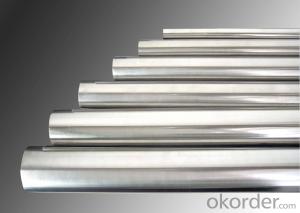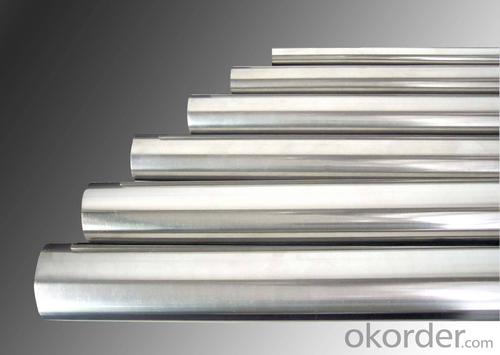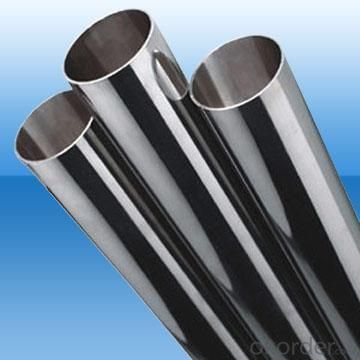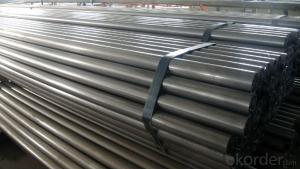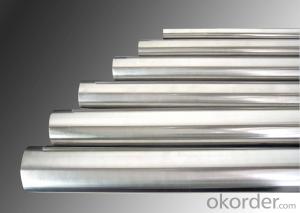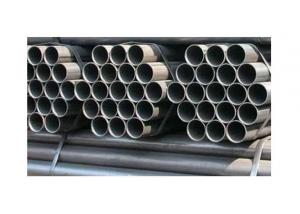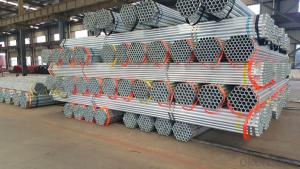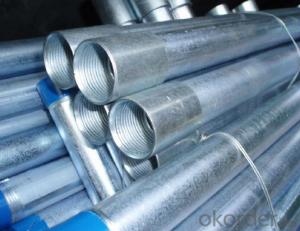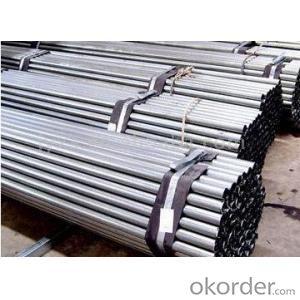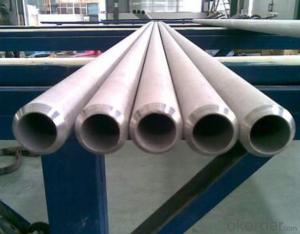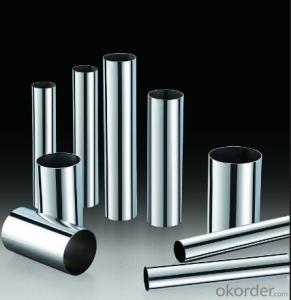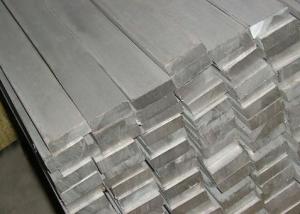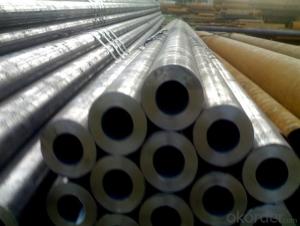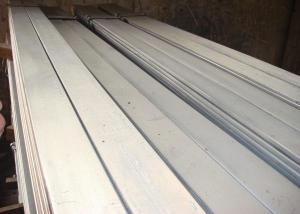Galvanized Cold Drawn Stainless Steel Pipe With 2 Plastic Caps
- Loading Port:
- Tianjin
- Payment Terms:
- TT OR LC
- Min Order Qty:
- 35 m.t.
- Supply Capability:
- 5000 m.t./month
OKorder Service Pledge
OKorder Financial Service
You Might Also Like
Specification
Galvanized Cold Drawn Stainless Steel Pipe With 2 Plastic Caps
1.Structure of Galvanized Cold Drawn Stainless Steel Pipe:
Seamless pipe is formed by drawing a solid billet over a piercing rod to create the hollow shell. As the manufacturing process does not include any welding, seamless pipes are perceived to be stronger and more reliable. Historically seamless pipe was regarded as withstanding pressure better than other types, and was often more easily available than welded pipe.
2.Main Features of the Galvanized Cold Drawn Stainless Steel Pipe:
• High manufacturing accuracy
• High strength
• Small inertia resistance
• Strong heat dissipation ability
• Good visual effect
• Reasonable price
3.Galvanized Cold Drawn Stainless Steel Pipe Specification:
Standard | GB, DIN, ASTM ASTM A106-2006, ASTM A53-2007 |
Grade | 10#-45#, 16Mn 10#, 20#, 45#, 16Mn |
Thickness | 8 - 33 mm |
Section Shape | Round |
Outer Diameter | 133 - 219 mm |
Place of Origin | Shandong, China (Mainland) |
Secondary Or Not | Non-secondary |
Application | Hydraulic Pipe |
Technique | Cold Drawn |
Certification | API |
Surface Treatment | factory state or painted black |
Special Pipe | API Pipe |
Alloy Or Not | Non-alloy |
Length | 5-12M |
Outer Diameter | 21.3-610mm |
Grade | 20#, 45#, Q345, API J55, API K55, API L80, API N80, API P110, A53B |
Standard | ASME, ASTM |
1) Material:20#(ASTM A 106/A53 GRB.API5LGRB,GB),45#,16Mn,10#.
2) Specification range:OD:21.3-610mm,WT:6-70mm,length:6-12m or according to the requirement of clients.
3) Excutive standards:GB,ASME API5L.ASTM A 106/A53,Despite of the above standards,we can also supply seamless steel pipe with standard of DIN,JIS,and so on,and also develop new products according to the requirements of our clients!
4) Surface:black lacquered,varnish coating or galvanized.
5) Ends:Beveled or square cut,plastic capped,painted.
6) Packing:bundles wrapped with strong steel strip,seaworthy packing.
4. Packing and Delivery:
Packaging Details: | seaworthy package,bundles wrapped with strong steel strip |
Delivery Detail: | 50-60days after received 30%TT or Original LC |
5. FAQ of Galvanized Cold Drawn Stainless Steel Pipe
How is the quality of your products?
Our products are manufactured strictly according to national and internaional standard, and we take a test on every pipe before delivered out. If you want see our quality certifications and all kinds of testing report, please just ask us for it.
Guaranteed: If products’ quality don’t accord to discription as we give or the promise before you place order, we promise 100% refund.
②How about price?
Yes, we are factory and be able to give you lowest price below market one, and we have a policy that “ for saving time and absolutely honest business attitude, we quote as lowest as possible for any customer, and discount can be given according to quantity”,if you like bargain and factory price is not low enough as you think, just don’t waste your time.Please trust the quotation we would give you, it is professional one.
③Why should you chose us?
Chose happens because of quality, then price, We can give you both.Additionally, we can also offer professional products inquiry, products knowledge train(for agents), smooth goods delivery, exellent customer solution proposals.Our service formula: good quality+good price+good service=customer’s trust
SGS test is available, customer inspection before shipping is welcome, third party inspection is no problem.
Any question, pls feel free to contact us !
6.Galvanized Cold Drawn Stainless Steel Pipe Images:
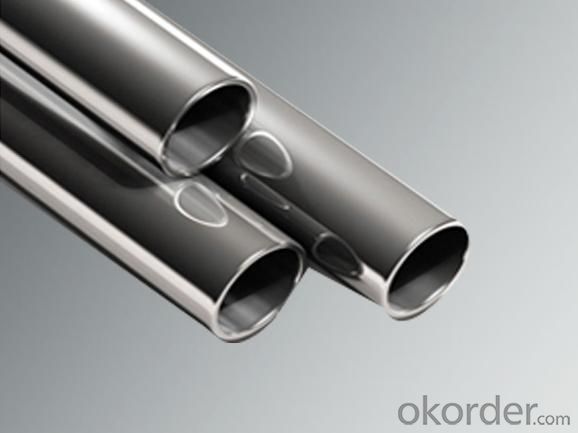
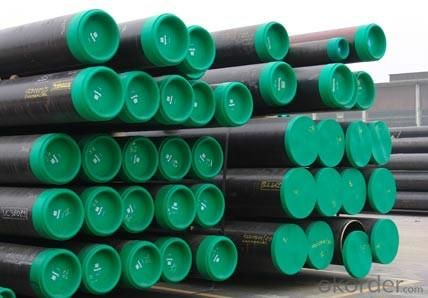
7. Company Information:
CNBM International Corporation (CNBM International) is the most important trading platform of CNBM Group Corporation, a state-owned company under the direct supervision of State-owned Assets Supervision and Administration Commission of the State Council.
Since 2004, the trading volume of CNBM International has been doubled in 5 successive years owing to the support of superior corporations and effort of all staff. Meanwhile, we have established strategic partnerships with hundreds of domestic manufacturers and sound business relations with clients from over 120 countries. Currently, we have wholly-owned overseas subsidiaries and branches in 5 countries with a view to realize localization, which also represents an essential progress in our globalization target.
In line with the business, CNBM International launched E-business platform Okorder.com.Our goal is to transform CNBM International into the global leading brand in building materials industry within 3 to 5 years through innovation and reform, by strengthening the overall management of supply chain, developing and cultivating both domestic and overseas market, improving the procedure and information system, enhancing the ability to organize resources and to provide value-added services under a professional team and a learning organization.
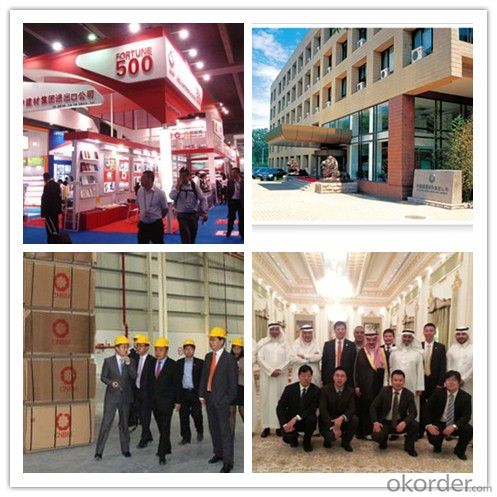
- Q: Can stainless steel pipes be used for firefighting systems?
- Firefighting systems can utilize stainless steel pipes due to their durability and resistance to corrosion. The material's ability to withstand heat, pressure, and chemicals makes it suitable for transporting water, foam, and other fire suppression agents. In addition to its high strength and ability to endure extreme conditions, stainless steel pipes are also recognized for their smooth inner surface, which reduces friction loss and maximizes water flow. This quality is crucial for the effectiveness of firefighting operations. Overall, stainless steel pipes offer a dependable and long-lasting solution for firefighting systems, ensuring safety and efficiency in critical situations.
- Q: Can stainless steel pipes be used for construction purposes?
- Yes, stainless steel pipes can be used for construction purposes. Stainless steel is known for its durability, corrosion resistance, and strength, making it suitable for various construction applications such as plumbing, structural support, and transportation of fluids and gases.
- Q: Are stainless steel pipes suitable for pharmaceutical laboratories?
- Stainless steel pipes are a suitable option for pharmaceutical laboratories. They are widely used in the pharmaceutical industry because of their exceptional resistance to corrosion, high strength, and durability. These pipes are also highly hygienic and easy to clean, making them perfect for pharmaceutical laboratories where cleanliness and sterility are crucial. Moreover, the smooth internal surfaces of stainless steel pipes prevent the buildup of bacteria, contaminants, or particles. Additionally, stainless steel is non-reactive and does not release any harmful substances, ensuring the quality and safety of pharmaceutical products. Overall, stainless steel pipes are a dependable choice for pharmaceutical laboratories as they fulfill the strict requirements for cleanliness, durability, and product safety.
- Q: Do stainless steel pipes require any special maintenance?
- Stainless steel pipes do not require any special maintenance as they are known for their durability and resistance to corrosion. However, regular cleaning and inspection are recommended to ensure optimal performance and longevity. This can be done by using mild soap and water or a non-abrasive cleaner to remove any dirt or grime that may accumulate on the surface. Additionally, inspecting the pipes for any signs of damage or leaks is important to address any issues promptly. Overall, stainless steel pipes are relatively low maintenance and can provide years of reliable service with proper care.
- Q: Is stainless steel flexible enough for plumbing applications?
- Yes, stainless steel is flexible enough for plumbing applications. It can be easily bent and shaped to fit the required plumbing configurations, making it a versatile and commonly used material in the plumbing industry.
- Q: Can stainless steel pipes be used for steam applications?
- Yes, stainless steel pipes can be used for steam applications. Stainless steel is highly resistant to corrosion and can withstand high temperatures, making it a suitable choice for carrying steam. Additionally, stainless steel pipes have excellent strength and durability, ensuring a reliable and long-lasting performance in steam applications.
- Q: What is the difference between 310 and 316 stainless steel pipes?
- The main difference between 310 and 316 stainless steel pipes lies in their chemical composition and intended uses. 310 stainless steel is a high-temperature resistant alloy that contains a higher amount of chromium and nickel compared to 316 stainless steel. This composition makes it highly resistant to oxidation and corrosion in high-temperature environments, making it suitable for applications such as furnace parts, heat exchangers, and other high-temperature industrial processes. On the other hand, 316 stainless steel is a more versatile and widely used alloy due to its excellent corrosion resistance properties. It contains a higher amount of molybdenum, which enhances its resistance to pitting and crevice corrosion, especially in chloride environments. This makes 316 stainless steel pipes suitable for various applications such as marine environments, chemical processing, and food processing industries. In summary, while both 310 and 316 stainless steel pipes offer corrosion resistance, 310 stainless steel is specifically designed for high-temperature applications, while 316 stainless steel is more commonly used for general corrosion resistance in various industries.
- Q: Can stainless steel pipes be galvanized?
- Yes, stainless steel pipes can be galvanized. Galvanization is a process in which a protective zinc coating is applied to steel or iron to prevent rusting. While stainless steel is already highly resistant to corrosion, galvanizing can provide an additional layer of protection in certain applications. However, it is important to note that galvanizing stainless steel pipes is not as common as galvanizing carbon steel pipes, as the inherent corrosion resistance of stainless steel is often sufficient for most applications. Additionally, galvanizing stainless steel can alter its appearance and may not be suitable for certain aesthetic requirements.
- Q: What's the difference between stainless steel seamless tube and stainless steel welded pipe?
- Stainless steel seamless steel tube is a kind of steel strip with hollow section and without seams.
- Q: How do you calculate the weight of stainless steel pipes?
- To calculate the weight of stainless steel pipes, you need to consider a few factors. Firstly, you need to determine the outer diameter (OD) and the thickness (T) of the pipe. Once you have these measurements, you can use the following formula to calculate the weight per foot (or meter) of the stainless steel pipe: Weight per foot (or meter) = (OD - T) * T * 0.0246615 This formula assumes that the stainless steel pipe is of a round shape. The weight per foot can then be multiplied by the length of the pipe in feet (or meters) to calculate the total weight. It is important to note that the density of stainless steel may vary depending on the specific grade and composition. Therefore, the weight calculated using this formula will provide an approximate value. If precise weight calculations are required, it is recommended to consult a reference table or contact the manufacturer for more accurate information.
Send your message to us
Galvanized Cold Drawn Stainless Steel Pipe With 2 Plastic Caps
- Loading Port:
- Tianjin
- Payment Terms:
- TT OR LC
- Min Order Qty:
- 35 m.t.
- Supply Capability:
- 5000 m.t./month
OKorder Service Pledge
OKorder Financial Service
Similar products
Hot products
Hot Searches
Related keywords
